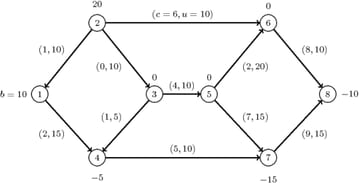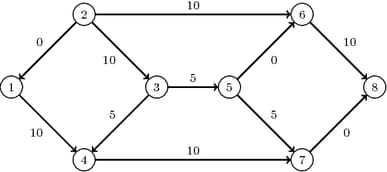The OPTNET Procedure
- Overview
-
Getting Started

-
Syntax
 Functional SummaryPROC OPTNET StatementBICONCOMP StatementCLIQUE StatementCONCOMP StatementCYCLE StatementDATA_ADJ_MATRIX_VAR StatementDATA_LINKS_VAR StatementDATA_MATRIX_VAR StatementDATA_NODES_VAR StatementLINEAR_ASSIGNMENT StatementMINCOSTFLOW StatementMINCUT StatementMINSPANTREE StatementSHORTPATH StatementTRANSITIVE_CLOSURE StatementTSP Statement
Functional SummaryPROC OPTNET StatementBICONCOMP StatementCLIQUE StatementCONCOMP StatementCYCLE StatementDATA_ADJ_MATRIX_VAR StatementDATA_LINKS_VAR StatementDATA_MATRIX_VAR StatementDATA_NODES_VAR StatementLINEAR_ASSIGNMENT StatementMINCOSTFLOW StatementMINCUT StatementMINSPANTREE StatementSHORTPATH StatementTRANSITIVE_CLOSURE StatementTSP Statement -
Details

-
Examples
 Articulation Points in a Terrorist NetworkCycle Detection for Kidney Donor ExchangeLinear Assignment Problem for Minimizing Swim TimesLinear Assignment Problem, Sparse Format versus Dense FormatMinimum Spanning Tree for Computer Network TopologyTransitive Closure for Identification of Circular Dependencies in a Bug Tracking SystemTraveling Salesman Tour through US Capital Cities
Articulation Points in a Terrorist NetworkCycle Detection for Kidney Donor ExchangeLinear Assignment Problem for Minimizing Swim TimesLinear Assignment Problem, Sparse Format versus Dense FormatMinimum Spanning Tree for Computer Network TopologyTransitive Closure for Identification of Circular Dependencies in a Bug Tracking SystemTraveling Salesman Tour through US Capital Cities - References
Minimum-Cost Network Flow
The minimum-cost network flow problem (MCF) is a fundamental problem in network analysis that involves sending flow over a network at minimal cost. Let ![]() be a directed graph. For each link
be a directed graph. For each link ![]() , associate a cost per unit of flow, designated by
, associate a cost per unit of flow, designated by ![]() . The demand (or supply) at each node
. The demand (or supply) at each node ![]() is designated as
is designated as ![]() , where
, where ![]() denotes a supply node and
denotes a supply node and ![]() denotes a demand node. These values must be within
denotes a demand node. These values must be within ![]() . Define decision variables
. Define decision variables ![]() that denote the amount of flow sent between node
that denote the amount of flow sent between node ![]() and node
and node ![]() . The amount of flow that can be sent across each link is bounded to be within
. The amount of flow that can be sent across each link is bounded to be within ![]() . The problem can be modeled as a linear programming problem as follows:
. The problem can be modeled as a linear programming problem as follows:
|
|
|
|
|
||
|
|
|
|
|
|
|
|
|
|
|
|
|
|
When ![]() for all nodes
for all nodes ![]() , the problem is called a pure network flow problem. For these problems, the sum of the supplies and demands must be equal to 0 to ensure that a feasible solution exists.
, the problem is called a pure network flow problem. For these problems, the sum of the supplies and demands must be equal to 0 to ensure that a feasible solution exists.
In PROC OPTNET, the minimum-cost network flow solver can be invoked by using the MINCOSTFLOW statement. The options for this statement are described in the section MINCOSTFLOW Statement.
The minimum-cost network flow solver reports status information in a macro variable called _OROPTNET_MCF_. See the section Macro Variable _OROPTNET_MCF_ for more information about this macro variable.
The algorithm used in PROC OPTNET for solving MCF is a variant of the primal network simplex algorithm (Ahuja, Magnanti, and
Orlin 1993). Sometimes the directed graph ![]() is disconnected. In this case, the problem is first decomposed into its weakly connected components, and then each minimum-cost
flow problem is solved separately.
is disconnected. In this case, the problem is first decomposed into its weakly connected components, and then each minimum-cost
flow problem is solved separately.
The input for the network is the standard graph input described in the section Graph Input Data. The links data set, which is specified in the DATA_LINKS= option in the PROC OPTNET statement, contains the following columns:
-
weightdefines the link cost
-
lowerdefines the link lower bound (the default is 0)
(the default is 0)
-
upperdefines the link upper bound (the default is
(the default is  )
)
The nodes data set, which is specified by the DATA_NODES= option in the PROC OPTNET statement, can contain the following columns:
-
weightdefines the node supply lower bound (the default is 0)
(the default is 0)
-
weight2defines the node supply upper bound (the default is
(the default is  )
)
To define a pure network where the node supply must be met exactly, use the weight variable only. You do not need to specify all the node supply bounds. For any missing node, the solver uses its default values.
The resulting optimal flow through the network is written to the links output data set, which is specified in the OUT_LINKS= option in the PROC OPTNET statement.
Minimum Cost Network Flow for a Simple Directed Graph
The following example demonstrates how to use the network simplex solver to find a minimum-cost flow in a directed graph. Consider the directed graph in Figure 2.42, which appears in Ahuja, Magnanti, and Orlin (1993).
Figure 2.42: Minimum-Cost Network Flow Problem: Data

The directed graph ![]() can be represented by the following links data set
can be represented by the following links data set LinkSetIn and nodes data set NodeSetIn.
data LinkSetIn; input from to weight upper; datalines; 1 4 2 15 2 1 1 10 2 3 0 10 2 6 6 10 3 4 1 5 3 5 4 10 4 7 5 10 5 6 2 20 5 7 7 15 6 8 8 10 7 8 9 15 ; data NodeSetIn; input node weight; datalines; 1 10 2 20 4 -5 7 -15 8 -10 ;
You can use the following call to PROC OPTNET to find a minimum-cost flow:
proc optnet
loglevel = moderate
graph_direction = directed
data_links = LinkSetIn
data_nodes = NodeSetIn
out_links = LinkSetOut;
mincostflow
logfreq = 1;
run;
%put &_OROPTNET_;
%put &_OROPTNET_MCF_;
The progress of the procedure is shown in Figure 2.43.
Figure 2.43: PROC OPTNET Log for Minimum-Cost Network Flow
| NOTE: ------------------------------------------------------------------------- |
| NOTE: ------------------------------------------------------------------------- |
| NOTE: Running OPTNET. |
| NOTE: ------------------------------------------------------------------------- |
| NOTE: ------------------------------------------------------------------------- |
| NOTE: Reading the links data set. |
| NOTE: Reading the nodes data set. |
| NOTE: There were 5 observations read from the data set WORK.NODESETIN. |
| NOTE: There were 11 observations read from the data set WORK.LINKSETIN. |
| NOTE: Data input used 0.00 (cpu: 0.00) seconds. |
| NOTE: Building the input graph storage used 0.00 (cpu: 0.00) seconds. |
| NOTE: The input graph storage is using 0.0 MBs of memory. |
| NOTE: The number of nodes in the input graph is 8. |
| NOTE: The number of links in the input graph is 11. |
| NOTE: ------------------------------------------------------------------------- |
| NOTE: ------------------------------------------------------------------------- |
| NOTE: Processing MINCOSTFLOW statement. |
| NOTE: The network has 1 connected component. |
| Primal Primal Dual |
| Iteration Objective Infeasibility Infeasibility Time |
| 1 0 20.0000000 109.0000000 0.00 |
| 2 0 20.0000000 109.0000000 0.00 |
| 3 5.0000000 15.0000000 104.0000000 0.00 |
| 4 5.0000000 15.0000000 103.0000000 0.00 |
| 5 75.0000000 15.0000000 103.0000000 0.00 |
| 6 75.0000000 15.0000000 99.0000000 0.00 |
| 7 130.0000000 10.0000000 96.0000000 0.00 |
| 8 270.0000000 0 0 0.00 |
| NOTE: The Network Simplex solve time is 0.00 seconds. |
| NOTE: The minimum cost network flow is 270. |
| NOTE: Processing the minimum cost network flow used 0.00 (cpu: 0.00) seconds. |
| NOTE: ------------------------------------------------------------------------- |
| NOTE: Creating links data set output. |
| NOTE: Data output used 0.00 (cpu: 0.00) seconds. |
| NOTE: ------------------------------------------------------------------------- |
| NOTE: ------------------------------------------------------------------------- |
| NOTE: The data set WORK.LINKSETOUT has 11 observations and 5 variables. |
| STATUS=OK MCF=OPTIMAL |
| STATUS=OPTIMAL OBJECTIVE=270 CPU_TIME=0.00 REAL_TIME=0.00 |
The optimal solution is displayed in Figure 2.44.
Figure 2.44: Minimum-Cost Network Flow Problem: Optimal Solution
| Obs | from | to | upper | weight | mcf_flow |
|---|---|---|---|---|---|
| 1 | 1 | 4 | 15 | 2 | 10 |
| 2 | 2 | 1 | 10 | 1 | 0 |
| 3 | 2 | 3 | 10 | 0 | 10 |
| 4 | 2 | 6 | 10 | 6 | 10 |
| 5 | 3 | 4 | 5 | 1 | 5 |
| 6 | 3 | 5 | 10 | 4 | 5 |
| 7 | 4 | 7 | 10 | 5 | 10 |
| 8 | 5 | 6 | 20 | 2 | 0 |
| 9 | 5 | 7 | 15 | 7 | 5 |
| 10 | 6 | 8 | 10 | 8 | 10 |
| 11 | 7 | 8 | 15 | 9 | 0 |
The optimal solution is represented graphically in Figure 2.45.
Figure 2.45: Minimum-Cost Network Flow Problem: Optimal Solution
